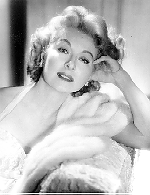 Greer Garson,
born to an Ulster Scot family and a receiver of the Wallace award. Greer Garson,
born to an Ulster Scot family and a receiver of the Wallace award.
Born on Sept. 29, 1908, in County Down, Ireland.
(or Ilford, London, in 1904)
ed. U. of London. She intended to become a teacher but instead joined an advertising
agency, dabbling in amateur dramatics in her spare time. In 1932 she made her professional
debut with the Birmingham Repertory Theatre and stayed with the company for two years. On
the London stage from 1934, she was seen by visiting Hollywood mogul Louis B. Mayer, who
signed her on an MGM contract. Her arrival in Hollywood was perfectly timed. MGM was in
dire need of a high-caliber leading lady to fill the vacuum soon to be created by the
retirement of Greta Garbo and Norma Shearer. Miss Garson became popular enough with her
very first film, Goodbye Mr. Chips, for which she received her first nomination for an
Academy Award (later nominations: Blossoms in the Dust, Madame Curie, Mrs. Parkington, The
Valley of Decision, and Sunrise at Campobello). But the film that propelled her to the top
was Mrs. Miniver, in which she symbolized the courage and gallantry of the British
housewife during the Blitz. She won the best actress Academy Award for the role, which had
been turned down by Shearer. Shortly after the film's release, in 1943, she married
Richard NEY, the actor who played her son in the film (her first marriage had ended in
divorce in 1937). She and Ney were divorced in 1947.Through the mid-40s, Miss Garson was
typecast in roles similar to that of Mrs. Miniver, combining moral courage and dedication
as a wife and a mother. Her frequent co-star was Walter Pidgeon. Later in the decade, she
was given an opportunity to demonstrate her versatility as an actress in a wider range of
drama and in comedy, but the quality of her vehicles and her popularity began to slip
after the end of WW II. In 1949 she married an oil magnate and several years later she
retired from the screen. In 1958 she took over Rosalind Russell's role in Broadway's
Auntie Mame and in 1960 she made a one-shot screen comeback in the role of Eleanor
Roosvelt in Sunrise at Campobello. She has subsequently appeared in occasional character
parts and once in a while in specials on TV. She lives on a ranch near Santa Fe, N.M. She
received numerous awards for environmental and other civic and benevolent activities. |
